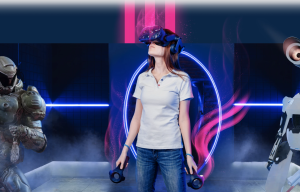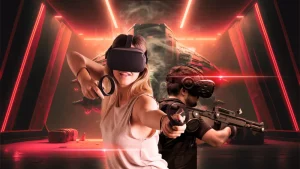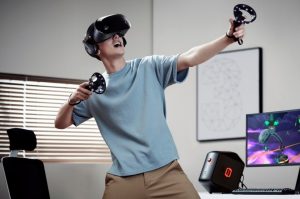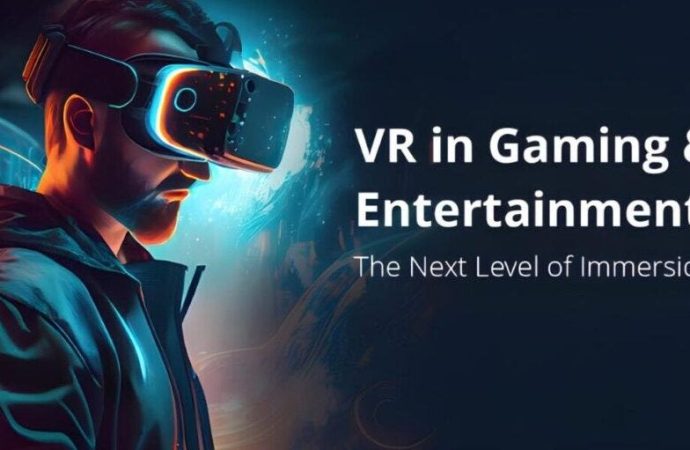Introduction Virtual Reality (VR) has emerged as one of the most transformative technologies of the 21st century, reshaping various sectors, including healthcare, education, and, notably, entertainment. This article delves into the role of virtual reality in shaping modern entertainment, highlighting its impact, applications, and future potential. The Evolution of Virtual Reality in Entertainment Early Beginnings
Introduction
Virtual Reality (VR) has emerged as one of the most transformative technologies of the 21st century, reshaping various sectors, including healthcare, education, and, notably, entertainment. This article delves into the role of virtual reality in shaping modern entertainment, highlighting its impact, applications, and future potential.
The Evolution of Virtual Reality in Entertainment

Image by: Google.com
- Early Beginnings
The concept of virtual reality is not new. Its roots can be traced back to the mid-20th century when Morton Heilig invented the Sensorama, a machine designed to simulate a multisensory experience. However, it wasn’t until the late 20th and early 21st centuries that VR technology began to mature, thanks to advances in computing power, graphics, and display technologies.
- Modern Developments
The 2010s witnessed significant strides in VR technology, with companies like Oculus (acquired by Facebook), HTC, and Sony leading the charge. The release of consumer-grade VR headsets like the Oculus Rift, HTC Vive, and PlayStation VR brought immersive virtual experiences to the masses, setting the stage for VR’s integration into modern entertainment.
Applications of Virtual Reality in Entertainment

Image by: Google.com
- Gaming
Gaming is arguably the most prominent sector where VR has made a substantial impact. VR gaming offers an immersive experience that traditional gaming cannot match. Players can physically move, interact with virtual environments, and experience a sense of presence that enhances gameplay. Popular VR games like “Beat Saber,” “Half-Life: Alyx,” and “The Walking Dead: Saints & Sinners” have garnered critical acclaim and commercial success.
- Cinematic Experiences
Virtual reality has also revolutionized the film industry. VR films and 360-degree videos offer audiences an immersive viewing experience, allowing them to explore scenes from different angles and perspectives. Filmmakers are experimenting with VR to create interactive narratives, where viewers can influence the storyline through their choices.
- Virtual Concerts and Events
The COVID-19 pandemic accelerated the adoption of virtual events, including concerts, festivals, and conferences. VR platforms like Oculus Venues, Wave, and Sansar have hosted virtual concerts featuring artists like Travis Scott, Marshmello, and Billie Eilish. These virtual events offer unique experiences, such as front-row seats, backstage access, and interactive elements, enhancing audience engagement.
- Theme Parks and Attractions
Theme parks and attractions are incorporating VR to create immersive rides and experiences. For example, Disney’s “Star Wars: Secrets of the Empire” and Universal Studios’ “The Walking Dead” VR attraction offer visitors a chance to step into their favorite fictional worlds. These experiences blend physical environments with virtual elements, providing a new level of immersion.
- Social VR
Social VR platforms like VR Chat, Rec Room, and Alt space VR enable users to interact with others in virtual environments. These platforms offer various activities, from virtual meetups and games to collaborative projects and events. Social VR is transforming how people connect, socialize, and collaborate, blurring the lines between the physical and virtual worlds.
The Impact of Virtual Reality on Modern Entertainment

Image by: Google.com
- Immersion and Presence
One of the most significant impacts of VR on entertainment is the sense of immersion and presence it provides. VR transports users to virtual worlds where they can interact with their surroundings and other users in ways that traditional media cannot. This heightened sense of presence enhances the overall entertainment experience, making it more engaging and memorable.
- New Storytelling Possibilities
VR opens up new storytelling possibilities for creators. Unlike traditional media, where the audience is a passive observer, VR allows for interactive and non-linear narratives. Viewers can explore different storylines, make choices that affect the outcome, and become active participants in the story. This interactivity adds depth and replay ability to entertainment content.
- Accessibility and Inclusivity
Virtual reality has the potential to make entertainment more accessible and inclusive. For example, VR can provide experiences that may be physically or financially inaccessible to some individuals, such as traveling to exotic locations or attending live events. Additionally, VR can offer customizable experiences that cater to different needs and preferences, ensuring that everyone can enjoy entertainment on their terms.
- Economic Impact
The rise of VR in entertainment has also had a significant economic impact. The VR industry has created new job opportunities, from hardware and software development to content creation and distribution. As VR continues to grow, it is expected to contribute significantly to the global economy, driving innovation and investment in the entertainment sector.
Challenges and Future Prospects

Image by: Google.com
- Technical Challenges
Despite its potential, VR faces several technical challenges that need to be addressed. These include improving the resolution and field of view of VR displays, reducing latency and motion sickness, and developing more intuitive input devices. Advances in these areas will be crucial for the widespread adoption of VR in entertainment.
- Content Creation
Creating high-quality VR content is a complex and resource-intensive process. It requires specialized skills, tools, and significant investment. As the demand for VR content grows, there will be a need for more streamlined and accessible content creation tools, as well as training and support for creators.
- Market Adoption
While VR has made significant strides, it is still in the early stages of market adoption. Factors such as the cost of VR hardware, the availability of content, and consumer awareness will play a crucial role in determining the future of VR in entertainment. Continued investment in research, development, and marketing will be necessary to drive adoption and growth.
Future Prospects

Image by: Google.com
The future of VR in entertainment looks promising. As technology continues to advance, we can expect more immersive and realistic experiences, seamless integration with other technologies like augmented reality (AR) and artificial intelligence (AI), and new applications that we have yet to imagine. VR has the potential to redefine entertainment, offering experiences that are more engaging, interactive, and personalized than ever before.
Conclusion
Virtual reality is playing a pivotal role in shaping modern entertainment. Its ability to provide immersive, interactive, and accessible experiences is transforming how we consume and engage with entertainment content. While there are challenges to overcome, the future of VR in entertainment is bright, promising new possibilities and experiences for creators and audiences alike. As VR technology continues to evolve, it will undoubtedly continue to redefine the landscape of modern entertainment, offering a glimpse into the future of immersive media.
















